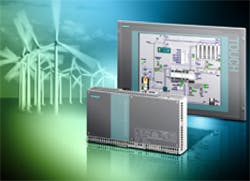SIMATIC Industrial PCs
The industrial environment can be pretty hostile to computing equipment. Equipment has to be hardened and shielded against vibration, shock, heat and EMC before it can be expected to function consistently in the factory, meaning it often takes a little extra time for the latest computing technologies to filter down from the consumer and office markets to the shop floor.
Siemens' industry automation group has released the Simatic IPC427C compact Microbox PC and the Simatic HMI IPC477C Panel PC -- industrial embedded PCs equipped with Intel Core 2 Duo processors (2x 1.2 gigahertz), effectively doubling the computing power available in preceding models, namely the 427B Microbox PC and the 477B Panel PC.
"These new fanless PCs deliver unprecedented power to the shop floor, answering a critical need" says Siemens spokesperson Kai Bronzel. "A dual-core processor effectively has two brains, effectively doubling the computing capability. These devices deliver the ability for customers to run the same tasks they do now with half the computers or write and run more involved applications."
Multi-core processors enable parallel processing, meaning tasks can be broken up into component parts and run concurrently, dramatically increasing processor speeds. Applications can be written to take advantage of this capability, called multi-threading. They also require significantly less power, which translates into less produced waste heat.
These new embedded industrial PCs are designed for maintenance-free, continuous 24-hour operation in environments with ambient temperatures of 0 to 50 degrees Celsius. They are also engineered to save valuable space in the plant. Thanks to its compact form factor (262 x 134 x 47 millimeters), the IPC427C fits into small control boxes or directly into a machine. It can be installed in various ways such as on a DIN rail, on a wall or in book-mounting style.Meanwhile the Simatic HMI IPC477C Panel PC, which comes with a HMI (Human Machine Interface) touchscreen panel (optional sizes of 12, 15 or 19 inches), has a depth of only 60 millimeters -- 20% thinner than its predecessor.
Adds Bronzel, "After space, reliability probably has the highest premium in most factories, and these devices deliver that through four gigabytes(GB) of the latest DDR3 memory, 32 GB Intel high-performance SATA solid-state SSD Extreme drives or up to two 8 GB compact flash cards.
"
With their enhanced power, lower footprint and reliability these embedded industrial PC's are long-term available (with a total service and support period of 8 - 10 years following market launch) and ideal for the space-saving implementation of highspeed MSR, HMI and communication tasks in the immediate vicinity of the machine."
Highlights:
Three PCI-104 expansion slots and a host of interfaces:
■ Two Gigabit Ethernet interfaces (with teaming function) for establishing redundant networks.
■ Four USB 2.0 interfaces and an optional PROFIBUS connection or one PROFINET interface with three ports (available soon) for a high degree of adaptability and flexibility.
■ Can be easily and flexibly expanded with a central I/O, with up to 12 encoder and counter interfaces and 320 digital and 120 analog I/O interfaces.
Note: The Simatic HMI IPC477C Panel PC is tentatively scheduled to be launched in late August, 2009.

